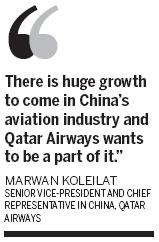 A comfortable bathroom, the latest Hollywood movies or a Starbucks latte with caramelized cheesecake - these are just some of the small luxuries Chinese high-end travelers demand while on the move.
A comfortable bathroom, the latest Hollywood movies or a Starbucks latte with caramelized cheesecake - these are just some of the small luxuries Chinese high-end travelers demand while on the move.
Since the fast-emerging middle-class has become the major force driving consumption in the country, sharp-nosed international airlines have spared no effort fending off competition for lucrative premium travelers in China.
Wang Jiangmin, an aviation analyst, said the core profitability of airlines usually comes from first- and business-class passengers.
Some industry insiders estimated that the number of first- and business-class guests account for about 9 percent of the total, but contribute more than 40 percent of revenues.
According to the International Air Transport Association (IATA), globally, first- and business-class passenger traffic grew by 10.9 percent in the first 10 months of 2010, compared with a 7.6 percent increase in economy-class passenger numbers.
In December, Cathay Pacific Airways, Hong Kong's biggest carrier, announced it would spend more than HK$1 billion ($129 million) introducing new business-class seats to attract high-spending premium travelers.
Air France, British Airways and Deutsche Lufthansa have also unveiled new first-class cabins this year as travel rebounds from the global recession.
Statistics from the Commercial Aircraft Corporation of China showed that by 2029 China will need 4,912 passenger jets, 3,447 more than it has today.
China's share of the global passenger jet fleet will rise from 8 percent to 14 percent by then as China becomes the frontline for many international carriers.
Marwan Koleilat, senior vice-president and chief representative in China of Qatar Airways, said: "There is huge growth to come in China's aviation industry and Qatar Airways wants to be a part of it.
"We have a mixture of passengers including laborers, students, tourists, businessmen and so on, but business traffic contributes the most."
He added that the broad network and quality services of Qatar Airways ensure its market position in China and average presence in the Chinese market is 90 percent.
"We currently fly to 95 destinations worldwide, operating a fleet of 95 aircrafts," said Koleilat. The company possesses 80 Airbus A350 aircrafts along with three A380 super jumbos.
It might be a truism that the essence of airline business is to give the customers what they want. But, as a five-star business, Koleilat said Qatar Airways was paying close attention to detail.
Qatar Airways introduced fully flat beds in business-class cabins in 2008 and now all new Boeing aircraft in the Qatar Airways fleet have them.
Business-class guests will be served a broad array of signature delicatessen food such as foie gras, caviar, smoked salmon as well as select vintage wines exclusive to Qatar Airways, in addition to Chinese cuisine.
As a sign of the company's "luxury" strategy, Qatar Airways invested more than $1 billion in improving the infrastructure of Doha International Airport, including the construction of a high-end terminal especially designed for first- and business-class passengers. Covering an area of 10,000 square meters (sq m), the premium terminal is equal to a five-star hotel with free international buffets, a 500-sq-m duty-free shopping mall, a spa and massage center, children's playground and conference center.
Koleilat said because of the strong connection between China and Qatar in terms of project construction, trade and tourism, more Chinese people will visit the premium terminal and their experiences would drive Qatar Airways' business in China.
Having planted its flag in Shanghai, Beijing, Guangzhou and Hong Kong, the company has also considered expanding its network into second-tier cities in the country.
The airline industry worldwide is expected to reap $15.1 billion in profits, a record amount, helped by $7.7billion in profits from the Asia-Pacific region, driven by China's economic growth, according to IATA, the airline industry's largest body, representing more than 230 airlines worldwide.
Long-haul airlines, such as Qatar Airways, Emirates and Etihad Airways, are adding new aircraft three times faster than their rivals in Europe and especially in Asia.





